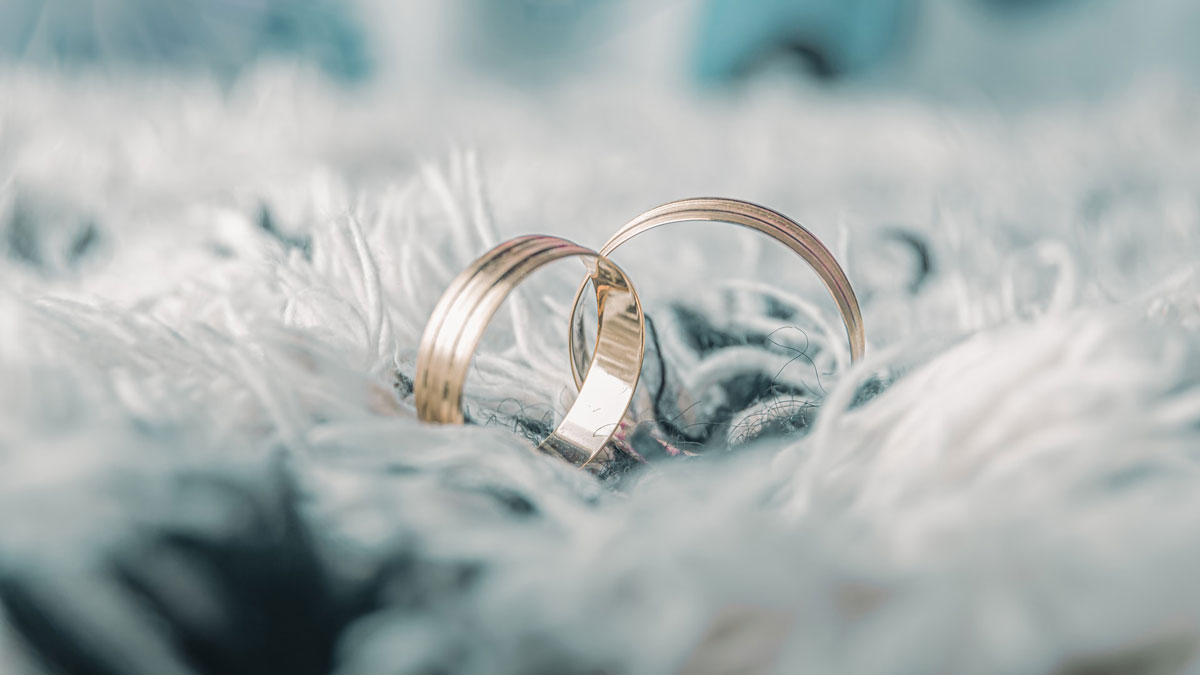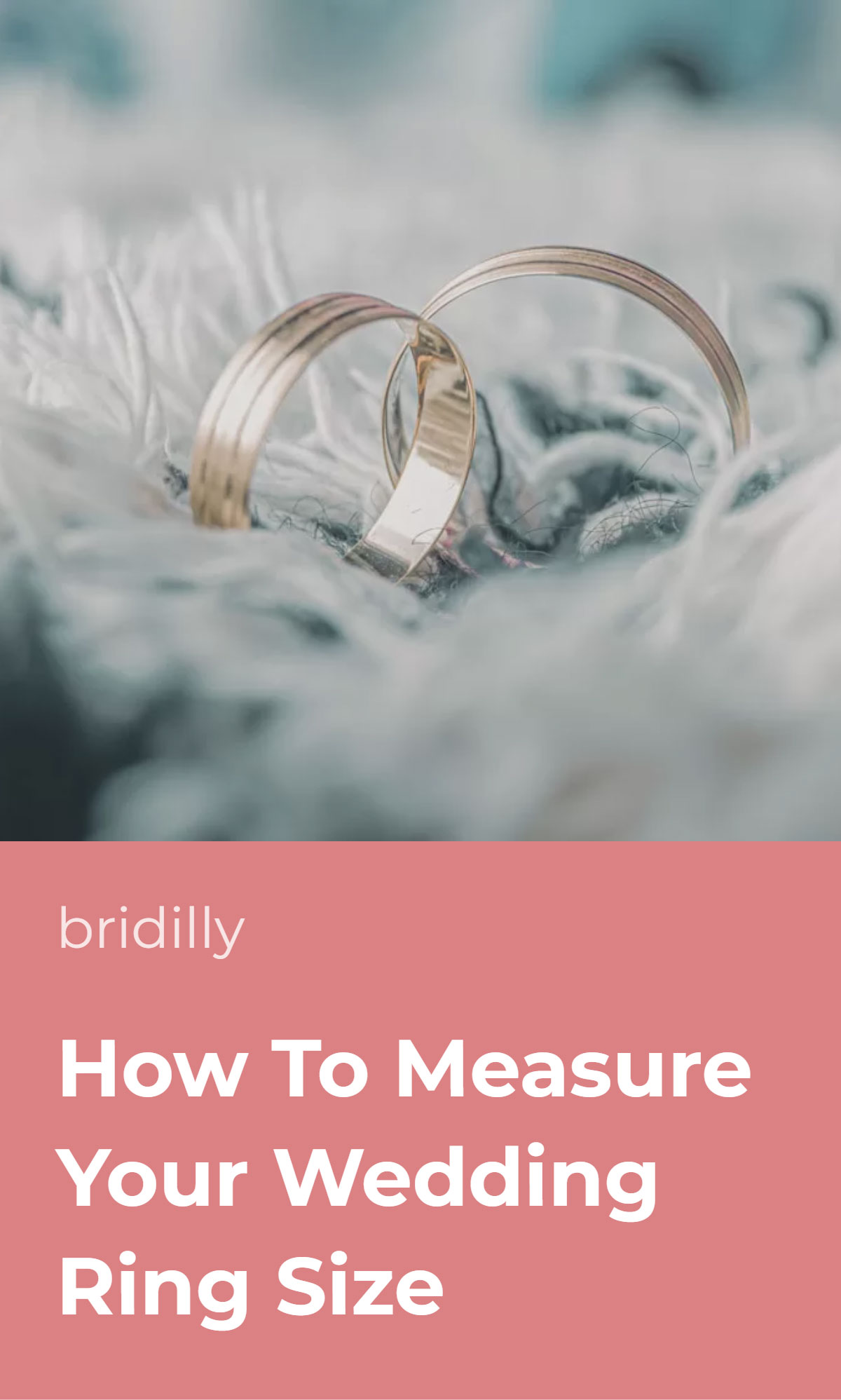Knowing how to measure wedding ring size correctly is vital for every bride and groom at the ring shopping choosing stage.
Many people wear their wedding band daily, so it must fit comfortably. Furthermore, unlike regular rings, wedding rings are traditionally worn on a specific finger.
Unfortunately, finding out the size at home can be tricky. You may use a plastic ring sizer, a string, or measure a ring you already own, but none of these methods are 100% accurate.
Numerous factors can affect our ring size, from the band’s width and material to the time of the day you measure it and room temperature.
Visiting a jewelry store and having your ring sized by a professional is always a good idea. However, if it’s not possible, don’t stress over the size – most bands can be resized if necessary.
Table of Contents [show]
Use a Ring Sizer
A ring sizer is a tool designed for measuring the ring size at home. They are typically made from plastic, but you can find a printable paper sizer if you don’t want to wait for the delivery of a plastic one.
You can find ring sizers in online marketplaces or online jewelry stores. They tend to be inexpensive, usually under $5.
The sizer can look like a zip tie, a card with multiple differently sized holes, or a keyring with dozens of plastic rings.
The benefits of plastic ring sizers include ease of use and relatively accurate measurements. Plus, you don’t have to leave your home. However, you would have to pay and wait for the delivery.
Use a String
The easiest way to measure ring size at home is to use a string or ribbon. A ribbon will do the job better because a string is very narrow.
Cut a piece of ribbon or string and wrap it around the base of your finger. Then, mark where the string first overlaps with a pen.
Note that string or ribbon can stretch, so don’t pull it. Otherwise, your ring size may be too large. Stretch the string along a measuring tape or ruler and measure the length in millimeters.
You may wrap the string around your finger five times and divide the result by five for a more accurate average result.
Then, convert your finger circumference in millimeters into a ring size using a standard U.S. ring size chart. The sizes go up by 0.8 millimeters, so every 0.4 millimeters is half size.
For example, a size four ring is 14.8 millimeters, while a size 4.5 is 15.2 millimeters. Measure your size multiple times to avoid mistakes. The string method isn’t the most accurate, but it’s quick and free.
If your finger circumference is between the sizes, pick the larger one. For instance, if your finger circumference is 15 millimeters, choose a 4.5 ring size.
Measure the Rings You Own
Another way to measure the ring size at home without paying a dime is to check the sizes of rings you already own. However, this method is only suitable if you own a ring that fits your wedding ring finger.
Take a ruler or measuring tape and measure the inner diameter of your ring in millimeters. Make sure you measure the widest part of the ring. Then, convert the result into a ring size using a chart.
Alternatively, you may print out a true-to-size ring size chart on paper and place your ring on it to skip the measuring and conversion steps. In this case, ensure you use the correct paper format.
Although this method is more accurate than the string method, it still isn’t perfect. Not all rulers are the same, and even a two-millimeter difference can play a significant role in wedding ring sizing.
Check your ring with multiple rulers or measuring tapes to get an average result.
Visit a Jewelry Store
Visiting a jewelry store and having your finger sized will give the most accurate results. Many brides wonder – can you come to a jewelry store only to measure the ring size? Won’t the jeweler consider it rude?
Of course, no one can say for all jewelers. However, many will be glad to help you find the correct ring size, especially for a wedding band. Jewelers don’t expect to sell something to every person visiting the store.
However, make sure you don’t intervene in communication with other customers if you don’t intend to buy anything from the store. Ideally, visit a store you consider purchasing from. Jewelers have special ring gauges and mandrels typically made from metal.
The measurements are more accurate because the material is solid, unlike plastic, string, or paper. You may order such a ring sizing kit online, but it may be pricey for one-off use.
Consider Your Knuckles
The main drawback of DIY wedding ring sizing, including the string and plastic sizer methods, is that you only measure the finger base. If you don’t consider the knuckle size, you may have difficulty pushing it over the joint.
The knuckle size may not be important for people with perfectly straight fingers, but it’s rare. If your knuckles are wider than the finger base, it’s best to opt for professional ring sizing.
If you can’t visit a jewelry store, use a plastic ring sizer or the string method to measure your knuckle size.
Fingers wider at the base than at the knuckles are known as tapered fingers. People with tapered fingers should choose a ring that fits snug at the bottom to avoid losing it because the ring can easily slip off.
Fingers with prominent knuckles wider than the base are called knotted, and sizing can be tricky. You may choose a ring based on the knuckle size, but in this case, it may be too loose at the base.
You likely won’t lose the ring, but it will rotate and feel uncomfortable. An ideal ring requires a bit of force to slide on, but you shouldn’t struggle with it.
If you need to use soap and water to take the ring off or notice indent marks at the finger’s base, the size is too small.
Sometimes, the finger base and knuckle circumference difference can be drastic. People with knotted fingers who struggle to find a comfortable ring may consider open bands or rings from soft materials like silicone.
The Ring Width & Material Matter
The necessary wedding band size may differ depending on its width. Wider bands have more friction and require more force to slip over your knuckle than narrow rings.
As a rule of thumb, go half a size up for bands over 3.5 millimeters wide unless you’ve measured your size based on a wide ring you already own.
Another factor affecting the wedding ring size is its material. Most wedding bands are made from solid metals that don’t stretch, so go a size up if you’re in-between sizes.
Typically, sizing down a ring is more straightforward than sizing it up. Some materials, like tungsten and titanium, can’t be resized.
If you want a modern silicone wedding band, go a size down because the material tends to stretch after a while.
When to Measure the Ring Size
Our finger size fluctuates numerous times throughout the day, so you should know how and when to measure the ring size to get the most accurate results. Firstly, decide on which hand you’ll wear the ring on.
The right-hand fingers are typically larger than the left-hand fingers in right-handed people. On the other hand, left-handed people may have larger fingers on the left hand because they use it more actively.
Don’t measure your fingers in a cold room or when you’ve just returned from the street in winter because fingers tend to shrink in cold temperatures.
The best time and place to measure the ring size is in a warm room at the end of the day. You may also measure your fingers after lunch when they are slightly swollen to ensure the ring will feel comfortable at any time.
Ideally, measure your finger base multiple times a day and find the average circumference to determine the best suitable ring size.
Know the Different Sizing Charts
Different countries and brands use different ring size measuring systems, and the sizing charts can get confusing.
U.S. ring sizes range from 0.5 to 13, with the smallest measuring 37.8 millimeters in circumference and 12.04 millimeters in diameter and the largest one 68.5 millimeters in circumference and 21.79 millimeters in diameter.
U.S. ring sizes have half-step increments, each equaling 0.4 millimeters in circumference. So, if U.S. size 0.5 equals 37.8 millimeters, size 1 equals 39.1 millimeters. The average women’s wedding ring size is U.S. 6, and men’s U.S. 8.5.
E.U. ring sizes range from 38 to 69, so E.U. size 38 equals U.S. size 0.5, and E.U. size 69 equals U.S. size 13. E.U. ring sizes have full-step increments.
Meanwhile, jewelers in the U.K. use letters from A to Z instead of numbers. A is the smallest size and Z the largest.

















No Comments Add one
Leave a Comment